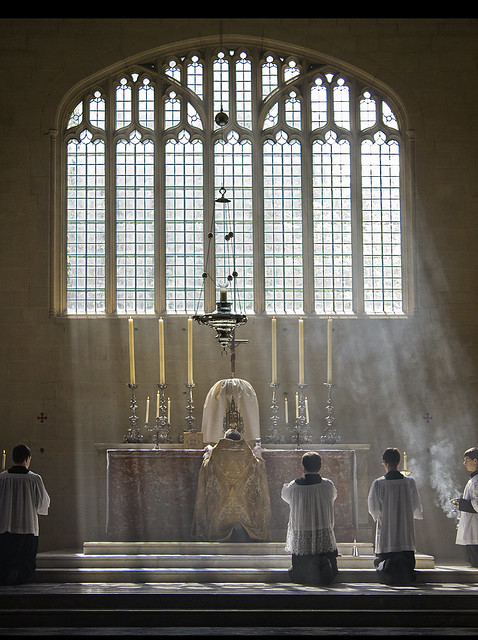
The altar is the most important furnishing in a church; it is its heart. This is because, as the Catechism of the Catholic Church says, "On the altar, which is the center of the church, the sacrifice of the Cross is made present under sacramental signs" (§1182). As the place where Christ's sacrifice is celebrated, it is elevated, like Calvary was. Moreover, it is customarily (but not necessarily) made of stone to give it permanence, to call to mind the altar in the Temple of Jerusalem, or Noah's stone altar, and also to commemorate Christ's Passion and death, because as St Thomas Aquinas observes, "Christ's body was laid in a stone sepulchre" (ST IIIa, 83, 3).
However, the altar is also made of stone because it stands as the symbol and image of Christ himself, and "the rock was Christ" (1 Cor 10:3). The idea that the altar is the primary symbol of Christ is found in the Fathers. For example, St Ambrose said that "The altar represents the body [of Christ] and the Body of Christ is on the altar". So, St Thomas says that "By the altar Christ Himself is signified, of Whom the Apostle says (Hebrews 13:15): "Through Him we offer a sacrifice of praise to God." Hence the consecration of the altar signifies Christ's holiness" (ST IIIa, 83, 3). So, the altar stands for Christ who died for our salvation.
As such, relics are traditionally placed in the altar to signify the martyrs gathered around Christ, which is an image from Revelation 5, and it is not the relics that make the altar holy, but rather, the altar (as a symbol of Christ) makes them, and indeed the whole church holy. Placed at the focal point of a church, then, it is all the saints - the holy people of God - who are gathered around the altar for the Eucharist. In this sense, the altar stands too for the risen and glorified Christ.
During the liturgy it is honoured with incense, and at its consecration, it is washed in holy water, anointed, clothed with white linen, and given candles, just as the baptised Christian is. As the altar is a symbol of Christ, it is fitting that there is only one, and it "represents the place where Christ himself steps into time and space among us. It thus represents him, himself, and deserves utmost reverence even outside the liturgy". Thus, the altar stands also for the incarnate Christ, and his dignity which we share through our baptism.
The Catechism adds that "the altar is also the table of the Lord, to which the People of God are invited". As such, it calls to mind the meal aspect of the Eucharist, but this is not in opposition to the sacrificial aspect. As the CCC §1383 says: "The Christian altar is the symbol of Christ himself, present in the midst of the assembly of his faithful, both as the victim offered for our reconciliation and as food from heaven who is giving himself to us".
So, at the altar, Christ gives himself to us for our sanctification, and he is offered by the Church, the "entire Christ", to the Father in the Holy Spirit for the greater glory of God. We are privileged to share in this offering whenever we participate in the Mass. Hence, we must prepare the altars of our hearts so that our entire lives might truly be a sacrifice of praise and thanksgiving to God. Thus, Romano Guardini says: "The two altars, the one without and the one within, belong inseparably together. The visible altar at the heart of the church is but the external representation of the altar at the centre of the human breast, which is God's temple, of which the church with its walls and arches is but the expression and figure". Therefore, the altar also stands for us, who are also made in the image of Christ through baptism and the Eucharist. As with an altar, Christ is given to the world through us Christians, and sacrifice is offered to God through our lives immolated and transformed by grace.
Thank you for this post! Are you really going through the whole alphabet?! (jumping up and down)
ReplyDeleteHow exciting!